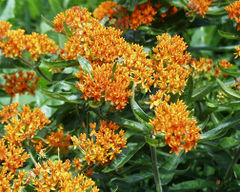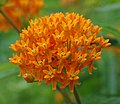Butterfly weed
| Asclepias tuberosa subsp. var. | Butterfly Weed | |||||||||||||||||||||||||||||||||||||||||||||||||||||||
|---|---|---|---|---|---|---|---|---|---|---|---|---|---|---|---|---|---|---|---|---|---|---|---|---|---|---|---|---|---|---|---|---|---|---|---|---|---|---|---|---|---|---|---|---|---|---|---|---|---|---|---|---|---|---|---|---|

|
|
| ||||||||||||||||||||||||||||||||||||||||||||||||||||||
| ||||||||||||||||||||||||||||||||||||||||||||||||||||||||
- Common names
- Butterfly Weed, Canada Root, Chigger Flower, Chiggerflower, Fluxroot, Indian Paintbrush, Indian Posy, Orange Milkweed, Orange Swallow-wort, Pleurisy Root, Silky Swallow-wort, Tuber Root, Yellow Milkweed, White-root, Windroot
Butterfly weed (Asclepias tuberosa) is a species of milkweed native to eastern North America. It is a perennial plant growing to 0.6-2 m (1 -2 feet) tall, with clustered orange or yellow flowers from early summer to early fall. The leaves are spirally arranged, lanceolate, 5-12 cm long and 2-3 cm broad.
This plant favors dry, sand or gravel soil, but has also been reported on stream margins. It requires full sun.
The common name comes from the butterflies that are attracted to the plant by its color and its copious production of nectar. Butterfly weed is also the larval food plant of the Queen and Monarch butterflies. The butterfly weed grows to be 1-3 feet long.
The plant looks similar to the Lanceolate milkweed (Asclepias lanceolata), but is uniquely identified by the larger number of flowers, and the hairy stems that are not milky when broken. It is most commonly found in fields with dry soil.
Cultivation
Propagation
Butterfly weed is easily propagated by cuttings in water.
Pests and diseases
Species
Subspecies indicated:
- Asclepias tuberosa interior, Central United States.
- Asclepias tuberosa rolfsii (Rolfs Milkweed), Southeast United States.
- Asclepias tuberosa tuberosa, Eastern United States.
Gallery
-
Entire plant from the ground to the flower
-
Young stems during spring
-
A young leaf
-
An emerging flower head
-
Closeup of the hairy stems
-
Closeup of unopened buds
-
Flower head
-
Closeup showing unopened, opening, and fully opened flower buds
-
Orange flowers
-
Red-striped orange flowers
-
Yellow flowers
References
- Standard Cyclopedia of Horticulture, by L. H. Bailey, MacMillan Co., 1963
External links
- w:Butterfly weed. Some of the material on this page may be from Wikipedia, under the Creative Commons license.
- Butterfly weed QR Code (Size 50, 100, 200, 500)










